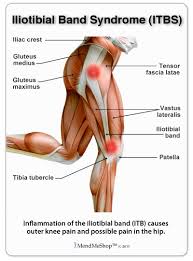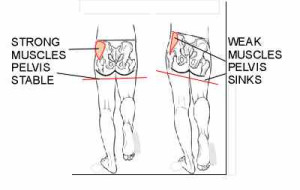Be “independent” from IT Band Pain this 4th of July!!
By Tiffany Davenport, PT, DPT
The popularity of running continues to increase and the upcoming Peachtree Road is as popular to Atlantans as ever. The Sports Rehabilitation Center would like to take this time to review some prevention and treatment concepts for a common overuse running injury referred to as Iliotibial Band Syndrome (ITBS).
What is the Iliotibial Band?
The IT band is a part of a group of muscles on the outside of the hip that serve to promote hip stability during running, restraining the leg from crossing midline when the foot hits the ground. The band starts at the hip area (the ilia) and crosses the outside of the knee joint to insert on the tibia of the lower leg.
How does ITBS occur?
If a runner has muscle imbalances due to weakness or tightness, abnormal running mechanics may occur. Altered running mechanics can cause the band to rub over the underlying bone with repeated knee flexion and extension. The resulting friction can lead to inflammation and irritation.
What are the causes of ITBS?
• As mentioned above, ITBS can be caused by muscle imbalances such as excessive muscle tightness or weakness
• Training errors: A runner who increased mileage too quickly, does too many hills, or runs on one side of a beveled road (which is slanted for drainage) is at greater risk for ITBS
• Incorrect shoes: A shoes that does not adequately control pronation or supination can also be a cause of ITBS
How can I prevent ITBS?
• Try changing your running routine. Instead of running only on a treadmill or a track, go for a run outdoors. Change the side of the street you run, cross training might also help to alleviate symptoms.
• Stick to a schedule for increasing mileage and remember: not too quickly!
• Stretching is a great way to avoid tight muscles, you can sign up for our newsletter to get a FREE home stretching program!
• Change your shoes as needed to prevent stress to ankles, hips and knees and maintain integrity of the tread.
How can I treat ITBS if I have it?
• Self soft-tissue mobilization: Foam rollers, tennis balls, and lacrosse balls are good methods of improving soft tissue mobility.
• Include exercises in your training routine that will strengthen your hip abductors
• If this strategy does not help, contact the experts at The Sports Rehabilitation Center and we can assess your running shoes, flexibility, and strength and design a program to meet your individual needs.
Good luck to all of those running the Peachtree Road Race this weekend! Please do not hesitate to contact one of the many specialists at the Sports Rehab Center with any further questions!
References
[i] Hamill J, Miller R, Noehren B, Davis I. A Prospective Study of Iliotibial Band Strain in Runners; Clinical Biomechanics [serial online]. April 2008.
[ii] van der Worp M, van der Horst N, de Wijer A, Backx F, Nijhuis-van der Sanden M. Iliotibial Band Syndrome in Runners: A Systematic Review; Sports Med [serial online]. 2012.
[iii] Baker R, Souza R, Fredericson M. Iliotibial Band Syndrome: Soft Tissue and Biomechanical Factors in Evaluation and Treatment; American Academy of Physical Medicine and Rehabilitation [serial online]. June 2011.